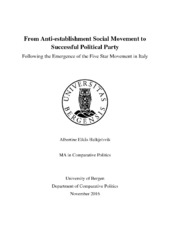From Anti-establishment Social Movement to Successful Political party - Following the Emergence of the Five Star Movement in Italy
Master thesis
Permanent lenke
https://hdl.handle.net/1956/15609Utgivelsesdato
2016-11-21Metadata
Vis full innførselSamlinger
Sammendrag
Using Social Movement Theory (SMT) and political party theory, this paper has explored the phenomenon of anti-establishment social movements transitioning to political parties. The focus has been on four propositions (P) that emerged as plausible explanations while studying theory. These propositions have been analyzed and discussed in relation to the chosen case of study, the Five Star Movement in Italy. The propositions were analyzed with data collected by the author in the field, using semi-structural interviews, and then compared to empirical evidence drawn from literature. The research question became, what main factors paved the way for the Five Star Movement to transition from an anti-establishment social movement to a successful political party? The interesting aspects of this research lies in its actuality. Anti-establishment movements and parties are on the rise. My research has given insight for understanding and developing a new theoretical path that combines SMT and political party theory. My findings: All the proposed propositions had influence, but some more than others. The most important ones were P4 (lack of trust in established institutions), then P2 (charismatic leader), then to some extent P1 (social media) and lastly with little influence P3 (neglected issues).
